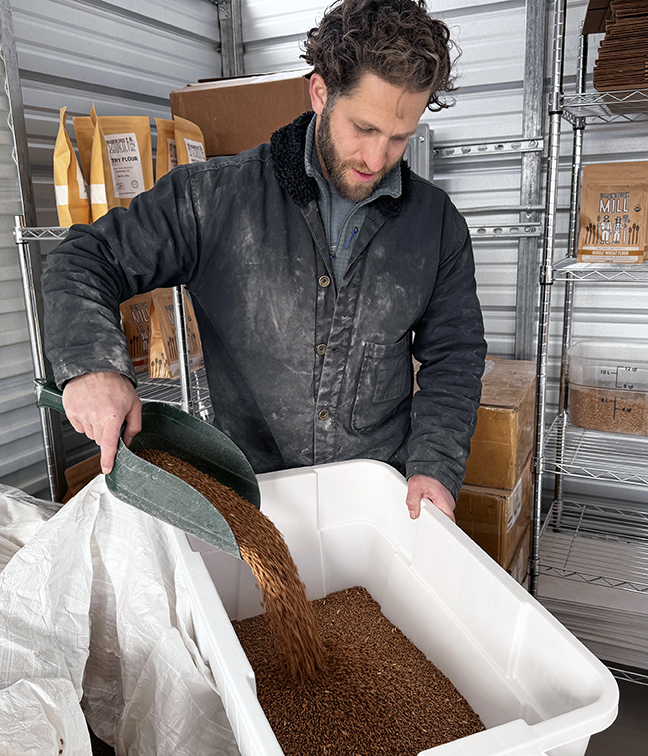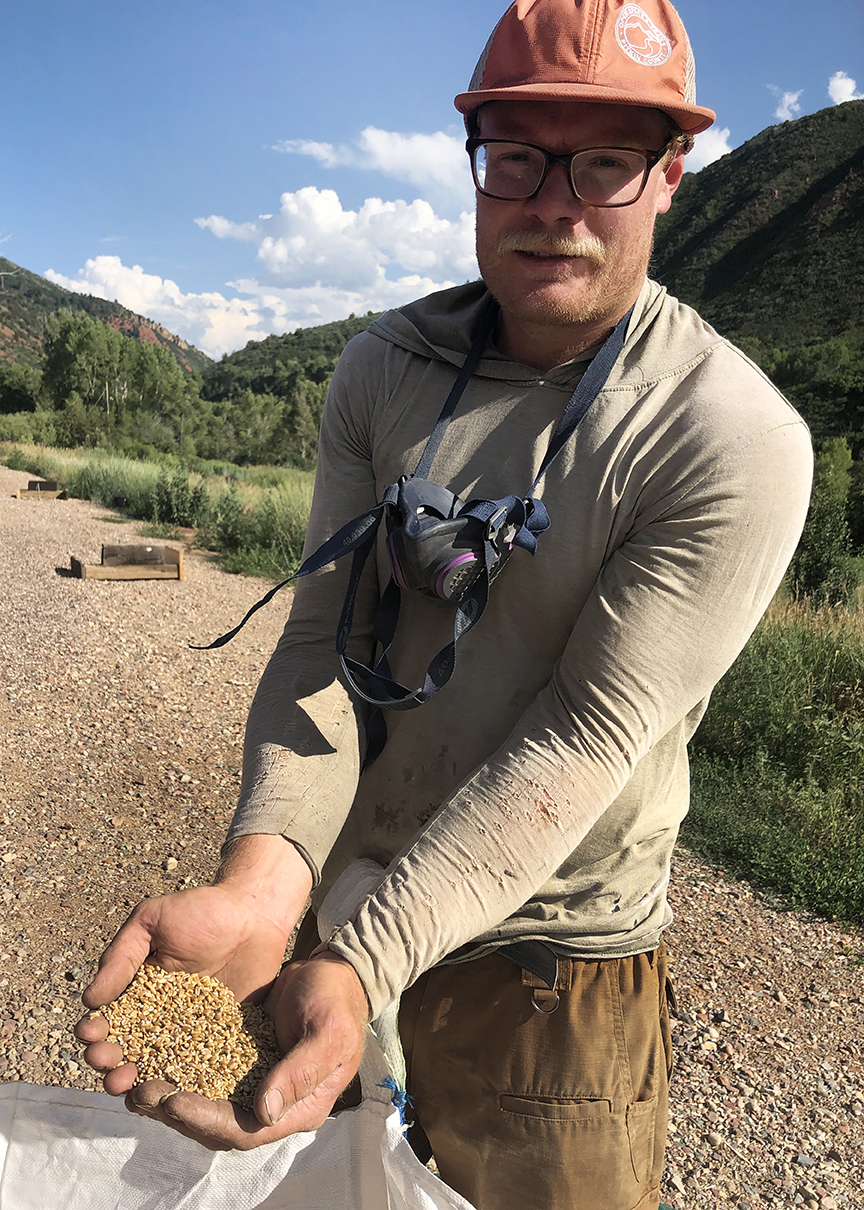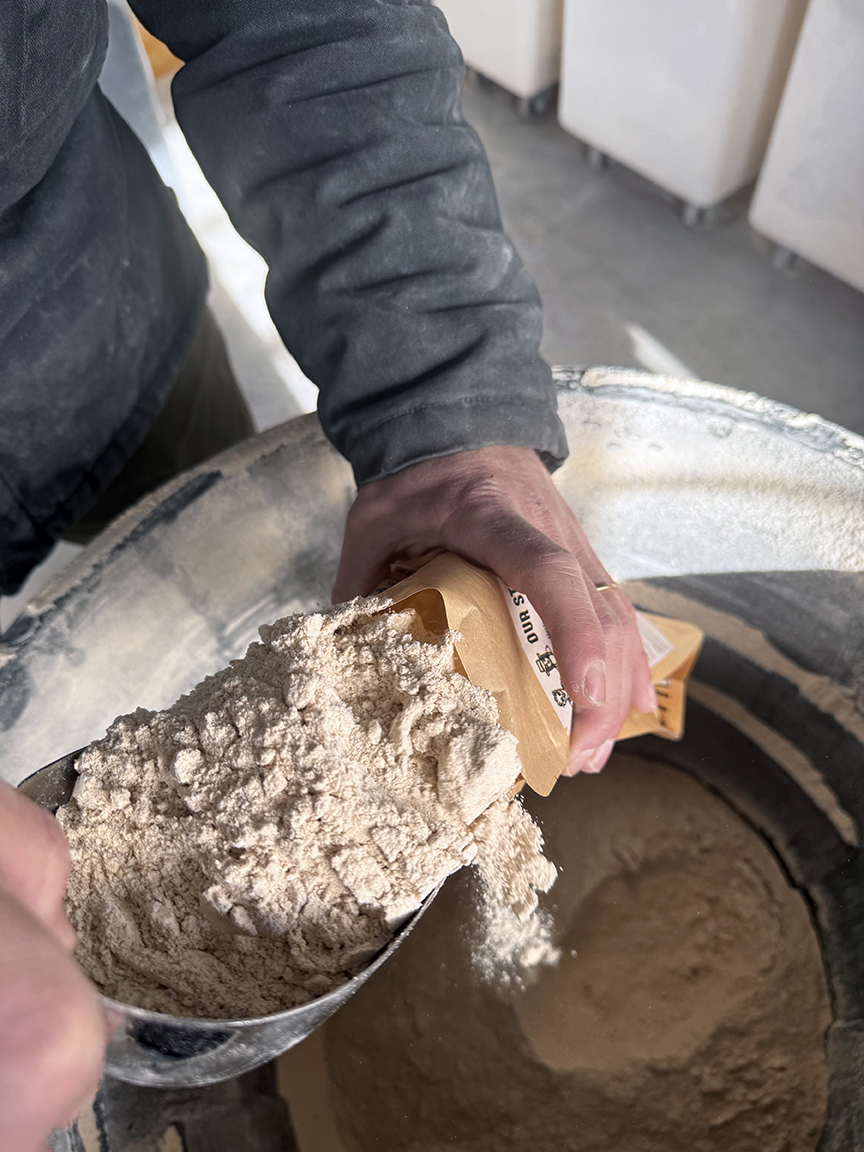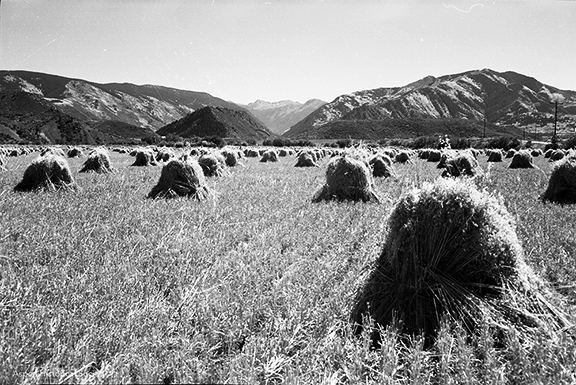Local mill germinates new interest in old grains

Jacob Trumbull prepares to grind locally grown wheat into flour.
A growing interest in local food production has brought new options for Roaring Fork Valley consumers. Thanks in part to Pitkin County open space parcels leased for agricultural use, the region has experienced a resurgence of locally raised meat, poultry, eggs, vegetables and dairy products.
The missing piece of the local food chain is grains, but at least one grower and the owner of a gristmill are hoping to rejuvenate this once-prominent component of the regional farming landscape. Cooper Means, owner of Shining Mountains Farm on Pitkin County’s Lazy Glen Open Space, will plant a fifth grain crop at Lazy Glen this spring. Just under four acres has seen one crop of rye, one of oats and two of wheat. His third planting of wheat will come this year after letting poultry do their work on the field last summer.
“To me it’s one of the big missing pieces in most local food economies,” said Means, whose grain field has been a work in progress as he experiments with a reduced tillage/no herbicide approach. Last season, some 250 chickens worked the land, keeping down weeds and improving the soil.
Means started with a small planting of rye, a cover crop that went mostly unharvested as he lacked the proper equipment. In 2020, a roughly 70-year-old combine acquired from the Midwest rattled to life at Lazy Glen and some 280 bushels of locally grown oats – likely the first such local harvest in decades – provided feed for Means’ poultry since he had no practical way to process the grain into flour or oatmeal.
Enter Jacob Trumbull. The former Vermont resident with a passion for sustainable agriculture set up a small mill at his residence on Missouri Heights. Late last year, Trumbull replaced the setup with a larger stone mill, manufactured in Vermont. Two circular granite stones (the top one weighs 900 pounds) grind grain into flour. An attachment allows him to sift the output into pastry flour, as well. The greater capacity allows Trumbull to mill 250 to 300 pounds of grain at a time.
Trumbull’s Roaring Fork Mill is a game-changer for anyone interested in growing grains in the valley, according to Means, who will plant his third crop of Rouge de Bordeaux wheat this spring. The hard, red wheat dates back several hundred years to the Bordeaux region of France, where bakers embraced the bread flour for its smooth, mellow flavor and tantalizing aroma. It is a variety that had all but disappeared from the U.S. before a renewed interest in heritage grains took hold, according to Trumbull.
“We’re working to bring back this style of wheat bread made with ancient and heritage grains,” he said.
Stone-ground flour retains the germ, bran and natural oils of the wheat berry, unlike bleached, enriched flour, in which all the nutrients are removed and then put back in (the enrichment part), Trumbull explained. Flour produced at his mill is more flavorful, nutrient-rich and less likely to trigger gluten sensitivity issues, he said.
“It’s why people who are gluten sensitive can go to Europe and eat bread and they’re fine,” Trumbull said.
Roaring Fork Mill is currently producing several varieties of flour from heirloom grains. They include Turkey red, white Sonora, Ryman rye, durum, millet and Rouge de Bordeaux. The grains are sourced from growers around Colorado, though Trumbull’s ultimate goal is to mill only grains produced in the Roaring Fork Valley. Means is currently the sole producer of Rouge de Bordeaux for the mill. Every bag originates with grain cultivated at Lazy Glen Open Space.
The mill’s flours are found at specialty food shops around the valley and Trumbull counts area restaurants/bakers among his customers. On a day in early January, his list of orders included 200 pounds of Turkey red, 100 pounds of white Senora all-purpose flour, 50 pounds of pastry flour (sifted white Senora) and 75 pounds of bread flour made with a combination of white Senora and Rouge de Bordeaux. The machinery hummed and a fine dust permeated the small building, lined with bags of flour and unmilled grain.
Trumbull was recently awarded a no-interest loan from the Aspen-based 2Forks Club to purchase about 2,200 pounds of Einkorn seed (the oldest known variety of wheat) and has an Emma grower willing to plant it. (The club makes zero-percent interest loans available to farming and food entrepreneurs in the Roaring Fork and North Fork valleys.)
Meanwhile, count farmer Harper Kaufman as a potential future grower of grain. Her Two Roots Farm at Emma Open Space is a thriving vegetable business, and she sells bags of Roaring Fork Mill flour at her weekly farm stand during the summer and fall, but there may be an opportunity to add grains to a back pasture on the property.
“I’ve always wanted to do grains…I’ve always wanted to grow full-staple food crops,” Kaufman said. Equipment and getting the grain to market are hurdles, but Trumbull’s mill provides a market and Means’ combine, which is available to rent, may make a grain crop at Two Roots feasible. The project is still a few years off, though, Kaufman said.
“It’s definitely something I’m excited to try,” she said. “Hopefully, it is in the future of the farm, for sure.”
Vegetables are viable for small growers because produce can be sold directly to consumers. Now, Roaring Fork Mill gives grains a foothold in the local marketplace that did not exist previously, according to Means. And, growing grains is not particularly difficult.
“It’s just a very viable crop here. It does well in these soils, it handles the frost,” he said. It also requires less water to grow than, say, alfalfa, but it does require post-harvest processing to separate wheat from chaff before it is ready for the mill.
If historical precedent is any indication, grain could be ripe for a resurgence of interest in the Roaring Fork Valley. Roaring Fork Mill provides what a pioneer mill on the banks of the Roaring Fork River south of Glenwood Springs once did for many an area farmer a century ago. Said the Glenwood Springs Post in 1914, “Do you realize that because of a mill in our midst the farmers are growing more wheat than ever before and they are finding a market for it almost at their ranch doors?”
Wheat, oats and barley were once familiar staples in the Roaring Fork Valley. Reports of bountiful harvests frequently made the news. In 1885, a Woody Creek-area ranch produced 250 bushels of oats, 70 bushels of wheat and 8 tons of hay, according to a Rocky Mountain Sun report. Well into the mid-20th century, Pitkin County farmers harvested 1,010 acres of oats, amounting to 49,100 bushels, according to the Colorado Department of Agriculture. In 1952, Pitkin County was listed seventh in total production among 15 Colorado counties that recorded winter wheat crops.
“If there is momentum from landowners, the transition is pretty easy and the impact is pretty large,” Means said.
– By Pitkin County Open Space and Trails

Cooper Means with his Rouge de Bordeaux wheat.

Bagging a sample of Rouge de Bordeaux flour.

Shocks of wheat stand in a field on the outskirts of Aspen in 1962. (Aspen Historical Society, Aspen Times Collection)
